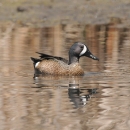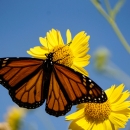Seasons of Wildlife
Spring
Quivira is a premier site to view shorebirds in the interior United States. As early as February, shorebirds start appearing in Quivira's wetlands on their northward migration. By May, thousands of shorebirds put on a spectacular display, especially around the Big Salt Marsh area. Over 35 shorebird species have been recorded at Quivira.
Summer
Here in central Kansas, many visitors are surprised and delighted to discover that Quivira attracts large numbers of herons and egrets each summer. The Refuge's wetlands attract these large, often colorful, long-legged waders. Quite often several species can be observed together.
Fall
Originally created as a refuge for migratory waterfowl, Quivira abounds with ducks and geese most of the year. The fall, however, can be the most spectacular season, with geese and ducks numbering in the hundreds of thousands at their peak in November.
Winter
Winter is the best time to view white-tailed deer. There are several hundred at Quivira, and during cooler days and/or near dusk, dozens can easily be viewed around the Refuge.
Featured Species
Quivira Refuge is located in a transition zone providing habitat for both eastern and western migratory bird species. Large numbers and concentrations of these birds occur on the Refuge, and a variety of rail species are also present. The refuge also supports a diverse population of reptiles and amphibians, as well as a prairie dog town. The Refuge provides critical habitat for the federally listed whooping crane and State-listed western snowy plover. Bald eagles winter and nest on the refuge, and rare interior least terns also nest here.





